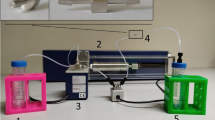Abstract
The use of the ultrasonic separation deviceis a very important step in the direction forimproving animal cell bioreactor cultures. However,the normal construction of the ultrasonic separationdevice ADI 1015 has an inherent disadvantage inpumping the cell suspension continuously through thedevice by using a peristaltic pump. The cells aretaken out of the reactor and are transported to theside inlet located below the separation chamber of thedevice. This cycling leads to cell death and aconsiderable reduction of the viable cell density. Themodification of the configuration of the device (nocirculation of the cell suspension through theretention device; during approximately 9 minutescell-free supernatant is extracted; every 9 minute forabout one minute, the volume which is equivalent tothe interior volume of the chamber and the tubingconnecting the device to the reactor, is flushed backin order to return the retained cells back to thereactor) allows cell densities from 106 to2.7 × 106 c/ml with a viability of at least90% (tested for the shear sensitive insect cell lineHigh Five), whereas the maximal cell densitiesobtained were 0.76 × 106 c/ml for the periodof continuous culture and 105 c/ml at the end ofthe use of the device in the classical mode.
Similar content being viewed by others
References
Gaida Th, Doblhoff O, Strutzenberger K, Katinger H, Burger W, Gröschl M, Handl B and Benes E (1995) Scale-up of ultrasonic resonance field cell separation devices used in animal cell technology. In: EC Beuvery et al. (eds) Animal Cell Technology: Developments towards the 21st Century (pp. 699–703), Kluwer Academic Publishers, Dordrecht.
Gaida Th, Doblhoff O, Strutzenberger K, Katinger H, Burger W, Gröschl M, Handl B and Benes E (1996) Selective retention of viable cells in ultrasonic resonance field devices. Biotechnol Prog 12: 73–76.
Kretzmer G and Schügerl K (1991) Response of mammalian cells to shear stress. Appl Microbiol Biotechnol 34: 613–616.
Trampler F, Sonderhoff SA, Pui PWS, Kilburn DG and Piret JM (1994) Acoustic cell filter for high density perfusion culture of hybridoma cells. Bio/Technology 12: 281–284.
Zhang J, Collins A, Chen M, Knyazev I and Gentz R (1998) Highdensity perfusion culture of insect cells with a BioSep ultrasonic filter. Biotechnol Bioeng 59: 351–359.
Author information
Authors and Affiliations
Rights and permissions
About this article
Cite this article
Merten, OW. Constructive improvement of the ultrasonic separation device ADI 1015. Cytotechnology 34, 175–179 (2000). https://doi.org/10.1023/A:1008147822625
Issue Date:
DOI: https://doi.org/10.1023/A:1008147822625




